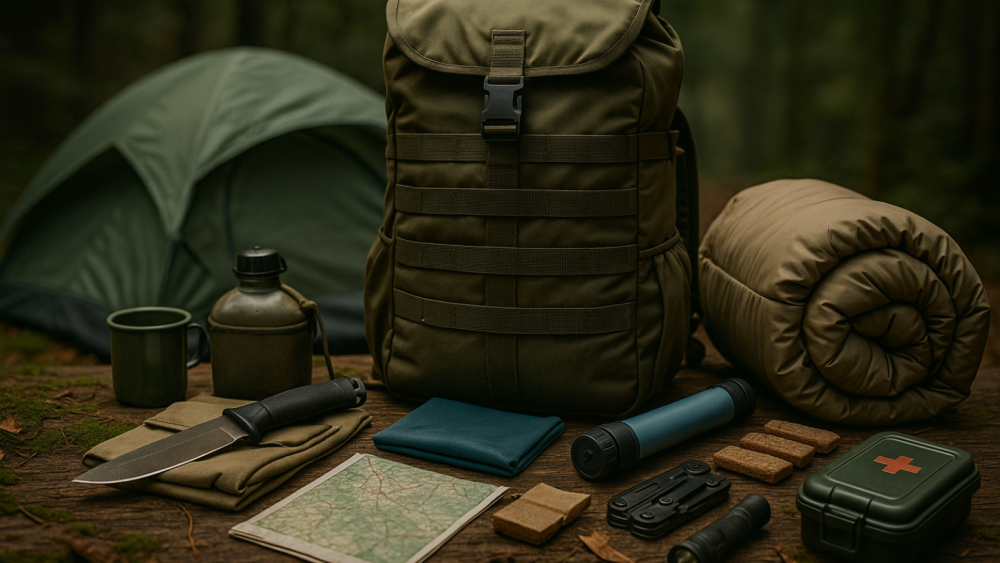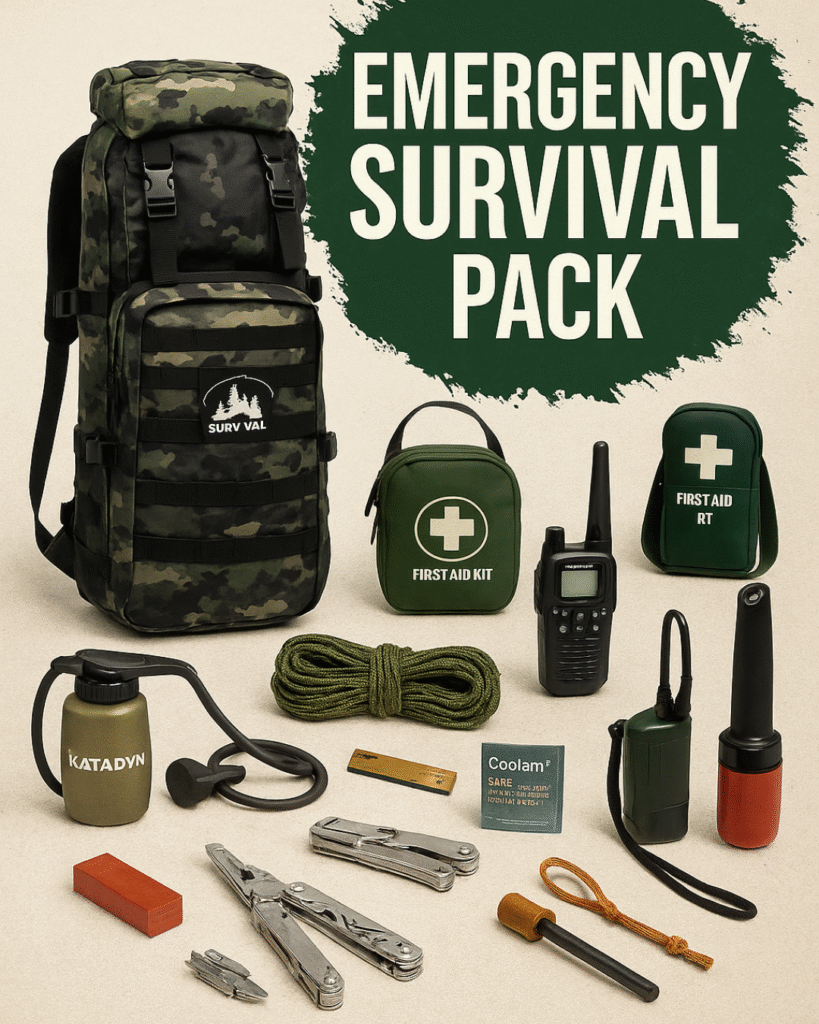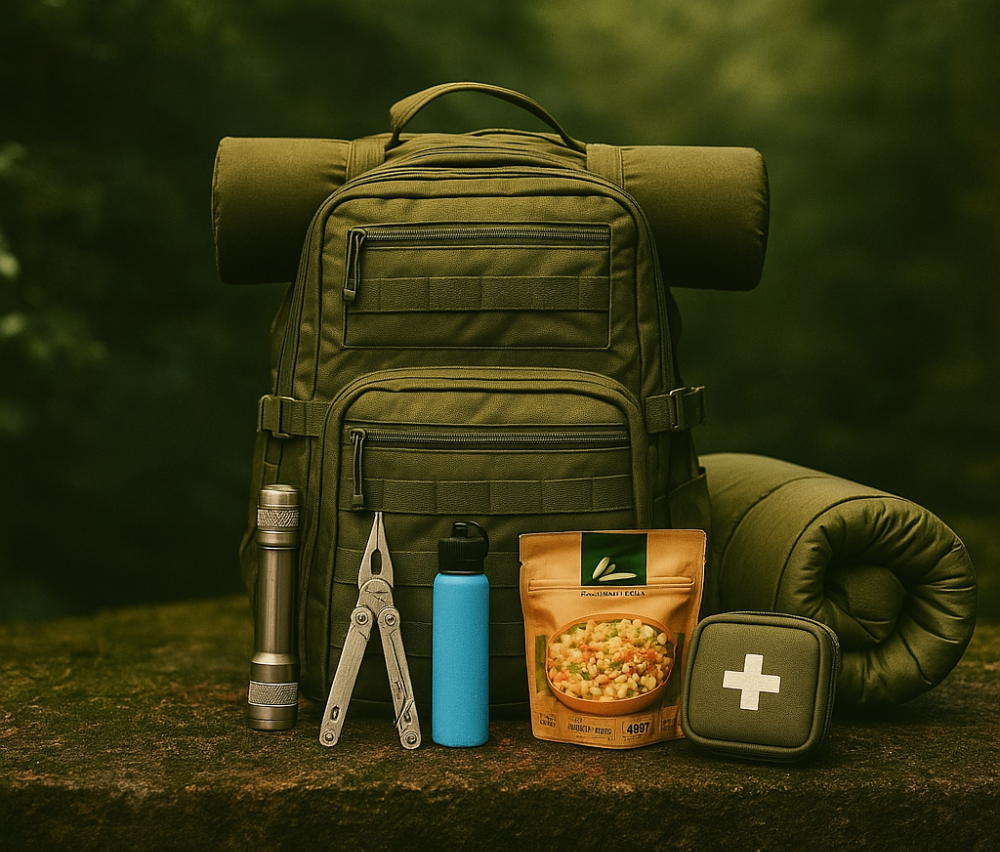
How To Build The Ultimate Bug-out Bag because in a world where the unexpected is now expected, preparation is everything.
As camping season rolls in, many of us are heading back into the wild, off-grid, under the stars, and away from our digital comforts. But whether you’re planning a weekend hike or bracing for an emergency, having the right gear in your bug-out bag is non-negotiable. This isn’t just about a camping checklistit’s your lifeline when things go south.
When disaster strikes, there’s no time to second-guess your gear. Whether you’re evacuating due to wildfire, grid failure, or civil unrest, your bug-out bag could be the one thing that keeps you safe, warm, and fed. In this guide, we break down exactly what you need in 2025 because survival isn’t just about instinct anymore, it’s about being equipped, updated, and ready to adapt

Affiliate Disclosure:
At TrailForge Gear, our mission is to share honest stories, rugged outdoor insights, and handpicked gear recommendations that support your wilderness adventures and backwoods romance reads. Some of the links you find on our site are affiliate links, meaning we may earn a small commission at no extra cost to you if you make a purchase through them.
As an Amazon Associate, we earn from qualifying purchases.
We only recommend gear, books, and tools we personally believe in or use ourselves, and we never let compensation influence our content or reviews. Your trust means everything to us, and every recommendation is made with your outdoor journey in mind.
Thanks for supporting TrailForge and helping us keep the fire going.
Bug-Out Bag FAQ (2025 Edition)

Q: What should I include in my bug-out bag in 2025?
Think beyond basics your bug-out bag should be future-ready. Pack a versatile multi-tool, a flashlight with alternative power sources, compact shelter gear, a cold-rated sleeping bag, a high-quality water filter, and energy-dense food that matches your diet. Add a solid first-aid kit and lightweight hygiene essentials. In short: pack for reality, not just theory.
Q: How much should a fully loaded bug-out bag weigh?
Your bag should strike the balance between portability and preparedness. Aim for 15–20% of your body weight. That ensures you can stay mobile under stress. Stick with compact, multi-use tools to shave off unnecessary pounds.
Q: How long should a bug-out bag sustain you?
Three days is the standard, but plan for flexibility. Think 72 hours minimum with buffer items extra snacks, spare socks, backup water purification. You may be out longer than expected.
Q: Are Amazon survival kits reliable?
Many are but they’re not all created equal. Read reviews, especially those from experienced preppers. Use kits as a launchpad, then add or swap out gear based on your region, skill level, and real-world testing.

250 PCS First Aid Survival Kit 13-in-1 Survival Kits,
Gifts for Men Dad Husband Him
Survival Gear and Equipment, Stocking Stuffers for Men Christmas Birthday Gifts, Cool Gadgets Gift for Outdoor, Gardening, Camping
1. Non-Negotiable Gear: What Every Bug-Out Bag Needs
A solid multi-tool is still king. It’s your go-to for repairs, food prep, self-defense, and just about anything else in the wild. Alongside that, pack a reliable flashlight preferably one with rechargeable batteries or a crank/solar option so you’re never left in the dark.
Shelter matters. A compact tent or weatherproof tarp plus a cold-rated sleeping bag will give you crucial warmth and cover. New tech means you can find gear that’s lighter and stronger than ever before.
Don’t skip a water purifier. Modern options are small and powerful, capable of turning even the sketchiest stream into a safe drink.
Survival Tip: Choose lightweight, multi-use gear. You need to carry fast, not heavy.
2. Health and Hygiene: Because Clean Means Alive,
Health tops the list during emergencies. Your first-aid kit should go far beyond a few bandages. Include antiseptics, gauze, ACE wraps, tweezers, burn gel, and meds for pain and allergies.
Hygiene matters too. Pack biodegradable wipes, hand sanitizer, and a small dental kit. Staying clean prevents illness, and in survival situations, that makes a huge difference.
If you take regular meds, talk to your doctor about getting an emergency backup. A few days’ worth can be life-saving.
Prep Like a Pro: Dental floss isn’t just for teeth. Use it for fishing, sewing, or gear repairs.
3. Skills and Tools: Know What to Do, Not Just What to Pack
Multi-tools and fire starters are great, but knowing how to use them is better. Learn basic survival skills now knot tying, fire building, and shelter construction are all critical.
Consider taking an online survival course. You’ll pick up skills like emergency first aid and map reading that could change everything in a crisis. And while GPS is great, make sure a physical map and compass are in your bag because batteries die.
Practice mock bug-out scenarios. The time to test your gear isn’t during an emergency.
Train Often: Panic fades when you trust your gear and your training.
4. Fueling Your Body: Smart Nutrition and Hydration
Focus on food that’s light, long-lasting, and calorie-dense. Energy bars, freeze-dried meals, jerky, and nut mixes are perfect picks. And don’t forget morale boosters like candy or chocolate.
Instead of lugging liters of water, rely on a compact purifier and purification tablets. Keep one backup method in case your primary filter fails.
Have dietary restrictions? Plan for those now. Plenty of gluten-free, keto, and vegan prep foods are available just check expiration dates.
Quick Tip: Always pack more food than you think you’ll need. Emergencies don’t follow a schedule.
5. Gear Kits & Amazon Bundles: Worth It or Not?
Amazon has tons of pre-packed survival kits. These can be a great way to start your bag, especially if you’re new to prepping. Look for highly rated bundles with a wide range of tools and supplies.
Still, personalized bags are often more effective. A hybrid approach is ideal—start with a bundle, then upgrade it with custom picks that match your needs.
Check reviews before you buy. Experienced preppers often leave gold nuggets in their feedback.
Hybrid Hack: Pair your own trusted items with a bundle to save time and boost reliability.
6. Final Phase: From Packed to Combat-Ready
Packing the bag is just step one. Real readiness comes from testing it. Go on hikes, simulate quick exits, or do overnight camps with just your bug-out bag. You’ll quickly learn what works and what needs tweaking.
Stay updated. Gear evolves and so do your needs. Make it a habit to inspect your bug-out bag quarterly.
Talk to other preppers. Online communities, local groups, and even YouTube channels can inspire fresh ideas and refine your setup.
And don’t do it alone. Prepping as a family or team strengthens everyone’s confidence and resilience.
Final Word: Your bag isn’t just gear—it’s your plan, your lifeline, and your peace of mind.

Conclusion:
A bug-out bag is more than a checklist. It’s a reflection of readiness, resilience, and respect for the unexpected. Build smart, stay sharp, and remember: when everything changes, the prepared stay steady.
➡️ Related Read: DIY Off-Grid Water Systems: What Every Prepper Should Know
🔗 Ready to pack your bag?
Visit TrailForgeGear.com for expert-tested tools, curated Amazon gear, and real-world prepper tips. Your future self will thank you.
And don’t miss our Off-Grid Water Solutions and Bushcraft Survival Tools for more mission-ready gear.
The 2025 focus really adds a timely layer to prepping, especially with how gear and priorities continue to evolve. One thing I’m wondering: how do you recommend balancing weight with utility for those in urban environments versus rural ones? Also, are there any underrated items that consistently prove useful but are often overlooked in most bug-out bag lists?
Appreciate the insight, Slavisa — and great questions too.
You’re absolutely right — the 2025 focus isn’t just about what’s trending, it’s about adapting to how fast everything is changing. Urban versus rural prepping definitely brings different challenges. In cities, compact and multi-use tools are gold — think pry bars, respirators, even cash. In rural areas, weight can stretch a bit more, so you can pack extras like heavy-duty tarp or a larger cook kit.
As for underrated gear?
• Contractor-grade trash bags — ultra versatile (shelter, rain cover, insulation, etc.)
• A mini crowbar — low weight, high value in both rescue and entry
• And for both environments: a printed local map. GPS is king until it’s not.
Thanks for dropping this — I might expand this into a follow-up blog. Stay sharp and stay ready.
Well done with your Bug out Bag. Did you personally create this idea and custom bag to fit all the camping equipment you carry, or is this just an idea you came up with?
Does this bag hold goods for a couple of people, or is it just for a single hiker and how long would the rations last for if packed into this bag of travel goodies? Are they all geared as classic vintage pieces or are you adding modern technology into the pack?
regards Helen
Hey Helen, thanks so much — great questions!
Bug-out bags have been around for a long time, but this setup is what I personally like to use. It’s based on real experience, trial and error, and what I’ve found actually works out there.
The bag I cover in the blog is built more for solo travel, but you could definitely tweak it to support two people for a short trip. The rations are meant to last about 72 hours, though if you add things like a water filter and some lightweight food tools, you can stretch it longer.
I like mixing classic survival gear with some modern tools think ferro rods and old-school compasses, but also solar power and tech that makes things easier without weighing you down.
Appreciate you stopping by always happy to chat more about gear anytime!
Cheers,
Shawn